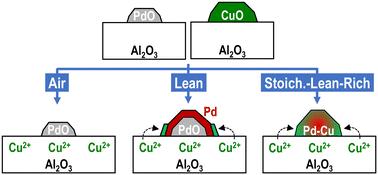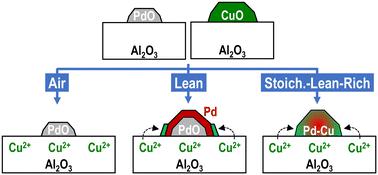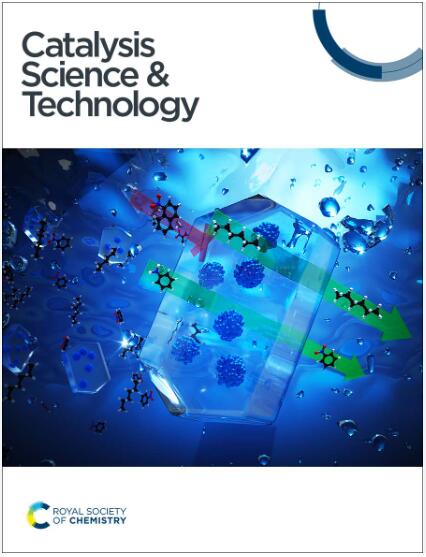Thermal deactivation of Pd/Al2O3–Cu/Al2O3-combined three-way catalysts via Cu migration and alloying†
IF 4.4
3区 化学
Q2 CHEMISTRY, PHYSICAL
引用次数: 0
Abstract
A Cu oxide catalyst supported on γ-Al2O3 (Cu/A) is a promising candidate for substituting platinum group metals in automotive three-way catalysts (TWCs). Cu/A can be used by mixing with a Pd catalyst supported on γ-Al2O3 (Pd/A). In this study, the effect of thermal aging on the nanostructure and TWC performance of the physically mixed powder catalyst (Pd/A + Cu/A) was investigated under different environments, that is, simulated exhaust gas mixtures dynamically fluctuating among stoichiometric, fuel-lean, and fuel-rich (SLR) compositions, compared with static fuel-lean (L) and air at 600–900 °C. The observed thermal deactivation was strongly dependent on aging atmosphere, and it increased in the sequence air < L < SLR with increasing aging temperature. Characterization studies showed Pd–Cu alloying in most deactivated SLR-aged catalysts in contrast to air-aged catalysts, which consisted of Pd oxide dispersed on the Cu2+-incorporated γ-Al2O3 phase. During SLR aging, some of the incorporated Cu2+ species migrated to the surface, reduced to the metallic state, and immediately reacted with Pd metal to form a Pd–Cu random alloy with face-centered cubic structure. This phenomenon severely deteriorated the NO reduction activity because the Pd surface enriched with Cu lacks NO dissociation ability. Therefore, the observed deactivation was more evident for NO reduction than C3H6 oxidation but was nearly negligible for CO oxidation because Cu2+-incorporated γ-Al2O3 exhibited high CO oxidation activity superior to that of Pd catalysts. Deactivation via Pd–Cu alloying was inevitable even in air- and L-aged catalysts when repeating the TWC light-off experiment under a stoichiometric gas mixture.


通过铜迁移和合金化实现 Pd/Al2O3-Cu/Al2O3 复合三向催化剂的热失活
以 γ-Al2O3 为载体的氧化铜催化剂(Cu/A)是替代汽车三元催化器(TWC)中铂族金属的理想候选催化剂。Cu/A 可以与支撑在 γ-Al2O3 上的 Pd 催化剂(Pd/A)混合使用。在本研究中,研究了热老化在不同环境下对物理混合粉末催化剂(Pd/A + Cu/A)的纳米结构和 TWC 性能的影响,即模拟废气混合物在 600-900 °C的静态稀油(L)和空气条件下,在化学计量、稀油和富油(SLR)成分之间动态波动。观察到的热失活与老化气氛密切相关,随着老化温度的升高,热失活率在空气 < L < SLR 的顺序中增加。表征研究表明,与空气老化催化剂相比,大多数失活的 SLR 老化催化剂中都存在 Pd-Cu 合金,后者由分散在 Cu2+ 嵌入的 γ-Al2O3 相上的氧化钯组成。在 SLR 老化过程中,部分融入的 Cu2+ 物种迁移到表面,还原成金属态,并立即与 Pd 金属反应,形成具有面心立方结构的 Pd-Cu 无规合金。这种现象严重降低了 NO 还原活性,因为富含 Cu 的钯表面缺乏 NO 解离能力。因此,观察到的失活现象在 NO 还原方面比 C3H6 氧化方面更为明显,但在 CO 氧化方面几乎可以忽略不计,因为 Cu2+ 嵌合的 γAl2O3 具有比 Pd 催化剂更高的 CO 氧化活性。在化学计量混合气体条件下重复 TWC 光脱实验时,即使在空气和 L 固化催化剂中也不可避免地会出现 Pd-Cu 合金失活现象。
本文章由计算机程序翻译,如有差异,请以英文原文为准。
求助全文
约1分钟内获得全文
求助全文
来源期刊

Catalysis Science & Technology
CHEMISTRY, PHYSICAL-
CiteScore
8.70
自引率
6.00%
发文量
587
审稿时长
1.5 months
期刊介绍:
A multidisciplinary journal focusing on cutting edge research across all fundamental science and technological aspects of catalysis.
Editor-in-chief: Bert Weckhuysen
Impact factor: 5.0
Time to first decision (peer reviewed only): 31 days
 求助内容:
求助内容: 应助结果提醒方式:
应助结果提醒方式:


